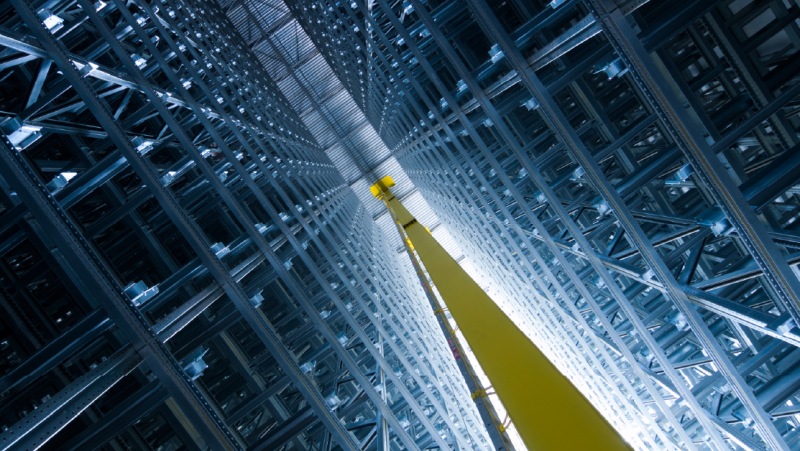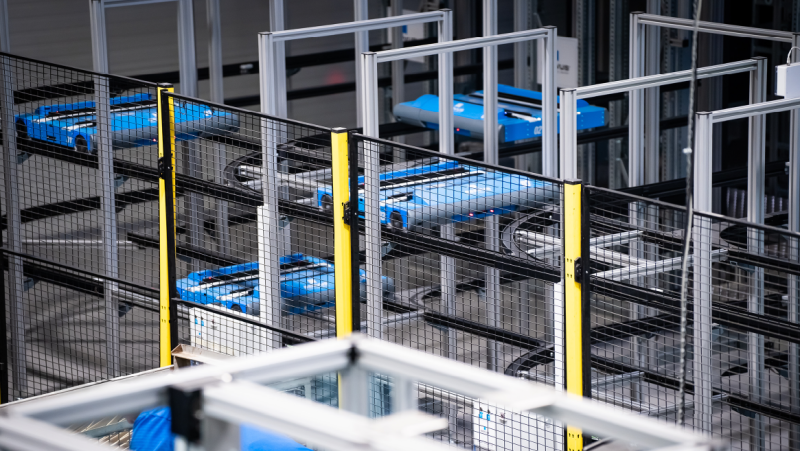Efficient in the Dark: The Five Phases on the Way to a Dark Warehouse
- Automation
- Article
Fully automated warehouses – dark warehouses – aren’t just science fiction anymore. They’re coming to the forefront in the real world. They operate without human intervention and in the dark, because their robots and machines can work without light, and their processes run based on system commands. What are the ideal steps and paths on the way to a dark warehouse? Can digital twins help with deploying these warehouses?
The phases on the way to your own dark warehouse
It’s quite common for automated processes to be rolled out gradually, leading to a partially automated warehouse. A factory can get very good results this way. But if the company wants a fully automated warehouse, greenfield construction is always the simplest. Let’s take a look at the planning and deployment of a dark warehouse within the five major steps through which a company will approach this goal.
Phase 0: To get the right automation design (choice of technology, suitable equipment and operating logic for the given technology) it’s important for the factory to provide its technology partner with precise data on its internal logistics and processes. The more data the technology partner receives, the more precisely it can design the specific solution, and the more realistic all simulations will be. This phase should never be underestimated. It is ideal to provide data for the last two to three years. This data can be obtained from the available digital tools, for example a plant’s existing warehouse management system (WMS).
Phase 1: The second step is to choose key technologies and transport systems (e.g. ASRS or VNA and vertical lift systems). All the processes and work procedures are also designed in this phase.
Phase 2: In the third step, designs need to be created for processing equipment, such as conveyors and depalletisers. It has fit into the warehouse and be positioned with an eye to maximally efficient use of the available space.
Phase 3: In the fourth step, it’s time to begin record-keeping, systems integration and programming for your new technologies and existing systems – including the construction of a digital twin. It’s also time for testing all the functions and methods, the API solution and the system interfaces.
Phase 4: In the last phase, your new fully automated warehouse is up and running. You now need to optimise it in real-world operation at different load levels.
A digital twin plays a fundamental role
A digital twin is an essential tool during the planning of a dark warehouse. It lets you shorten the deployment and launch and minimise subsequent change requests. It can be used not only for specific functional modules’ testing units, but also for comprehensive processes and different warehouse load levels. It also provides a valuable service during the testing of responses to exceptional situations. Users can easily simulate the scenario for any exceptional situation and verify whether the planned procedures are running as they should.
A virtual image of a planned warehouse thus offers a detailed view of all its processes. This lets a company try out changes to individual commands and immediately see the current positions of all tools and goods.
The art of integration
Dark-warehouse planning demands a different approach than what’s usually needed for traditional warehouses. That’s because it’s much harder to pinpoint various defects without humans around. And a single error can bring the whole warehouse to a halt. Getting it right requires know-how that’s often missing even at companies operating multiple warehouses. Experienced experts can identify critical situations in advance and propose solutions for them.
The same applies for the choice of equipment. For example, there are a lot of suppliers out there offering systems for fully automated warehouses. But which of these can work together in harmony to provide a comprehensive solution? Automation experts who have integrated a variety of systems in numerous projects and know the advantages and disadvantages of individual suppliers are best placed to find the right answers.
Naturally, running a dark warehouse requires a warehouse management and administration system that serves as a central platform and coordinates all the installed solutions, controls them, sends out commands and manages the data flows among interconnected systems over the appropriate interfaces. Such a platform should be designed from the ground up to communicate with goods-management systems (such as SAP) and offer flexible configuration. After all, it has to be able to deal with exceptional situations of every kind with no human intervention.
Share article
Top stories from logistics, production and IT.
Subscribe to Aimtec Insights
By registering, you agree to the processing of your personal data by Aimtec as described in the Privacy policy.
Get top stories and articles
from Logistics, Production and IT.
Subscribe to Aimtec Insights
By registering, you agree to the processing of your personal data by Aimtec as described in the Privacy policy.








